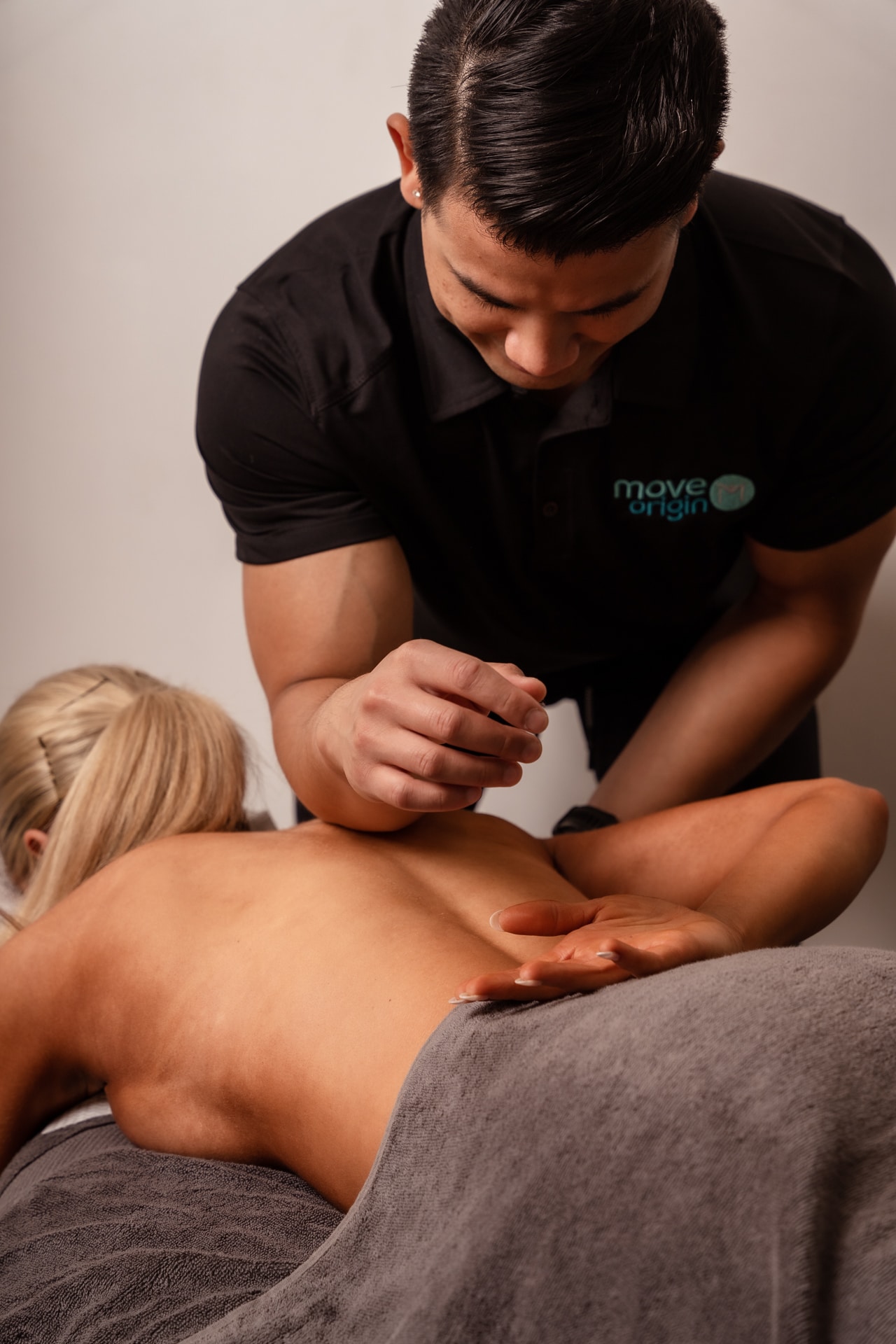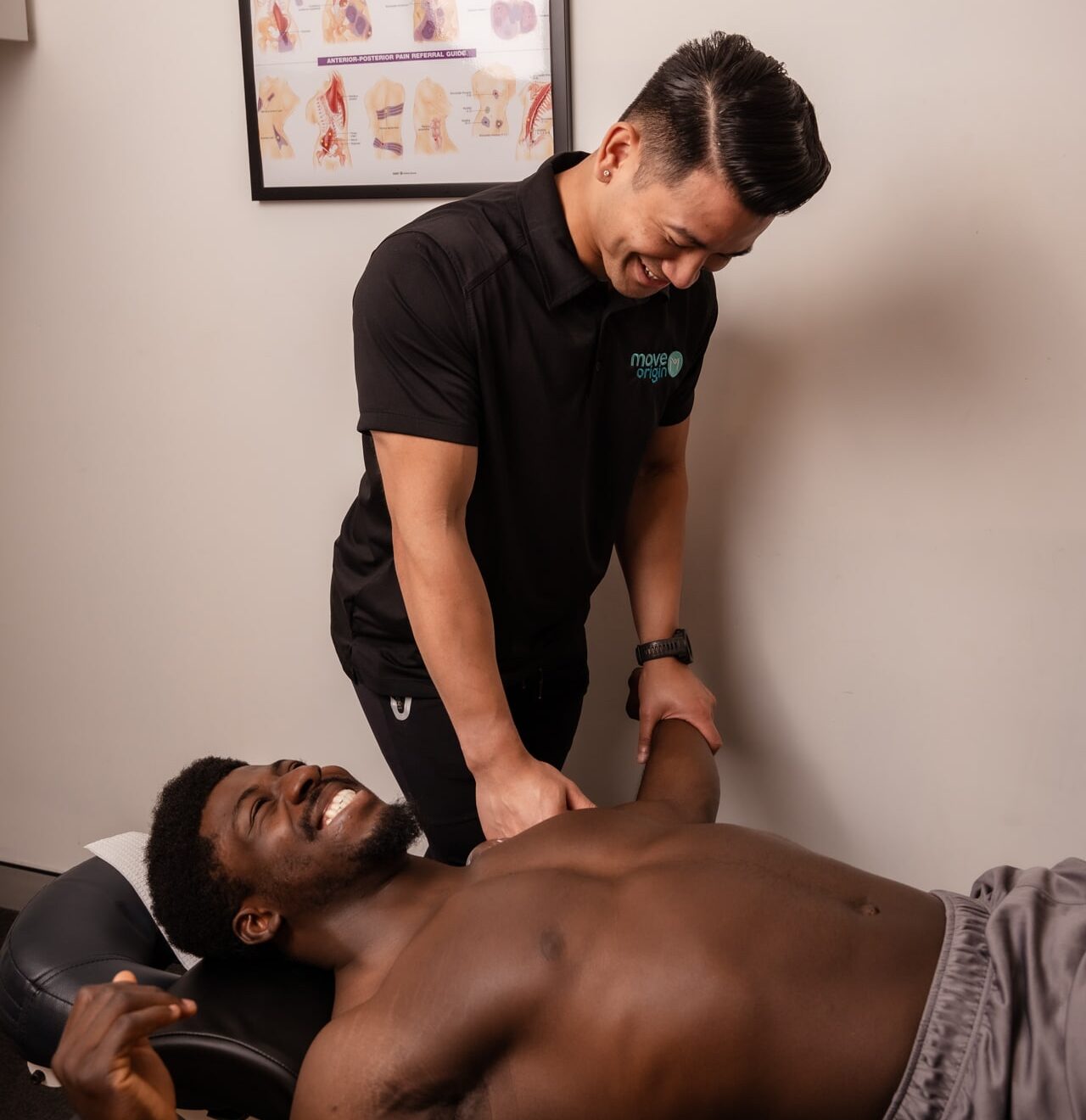Restore Movement
Trigger Point Therapy: Pain Relief and Muscle Recovery

What Is Trigger Point Therapy?
A trigger point is a painful area in a muscle that occurs when you push on it or what most people refer to as a knot. You’ve probably noticed that bit of the muscle when massaging your tense shoulders that doesn’t feel quite right and hurts. Trigger point therapy is a commonly used technique in manual therapy to alleviate pains caused by knotted muscles. The trigger point is identified by careful palpation of the muscle from its origin to its insertion. When a sensitive trigger point feels pain without being touched, this is one of the most common causes of muscular discomfort.
The tightness in the muscle and fascia that you would usually get as a knot in the muscle can be relieved using this type of soft tissue therapy. Trigger point therapy may be achieved through various techniques, including soft tissue treatment, deep tissue massage, dry needling, and ischemic pressure.
How Can Move Origin Help?
Our bodies are very complex, and to correct soft tissue dysfunctions, we consider how the human body functioning drives on the interrelations of many different elements. At Move Origin, we aim to resolve muscle tightness on presented problem areas, but more importantly, we are here to seek the root cause of the issue through examinations of surrounding areas.

Our Approach
We have a holistic approach to getting you back on your feet. At Move Origin, our goal is for each patient's treatment plan not only includes restoring range-of motion and stability but also building strength so they can be as active with their new lifestyle!
What is Trigger Point Therapy?
Trigger point therapy is a specialised massage technique that targets specific areas of muscle tension known as trigger points. These are hyper-irritable spots within muscle tissue that feel like small knots or tight bands when touched. Unlike regular muscle soreness, trigger points can cause pain both at the site of the knot and in other areas of the body through a phenomenon called referred pain. Think of trigger points as tiny muscle spasms that have become stuck in a contracted state. They develop when muscle fibers become overworked, injured, or stressed, creating areas of reduced blood flow and increased tension. Without proper treatment, these points can persist for months or even years, causing ongoing discomfort and limiting your mobility.The Science Behind Trigger Points
Research shows that trigger points contain increased levels of inflammatory chemicals and decreased oxygen levels compared to healthy muscle tissue. This creates a cycle where the muscle remains contracted, blood flow is restricted, and pain signals are continuously sent to the brain. Trigger point therapy works by applying sustained pressure to these problematic areas, helping to:- Increase blood flow to the affected tissue.
- Release muscle tension and restore normal function.
- Break the pain-spasm cycle.
- Reduce inflammation and promote healing.
Benefits of Trigger Point Treatment
Immediate Pain Relief
One of the most compelling aspects of trigger point treatment is its ability to provide rapid pain relief. Many clients experience significant improvement in their symptoms within a single session. This immediate response occurs because the therapy directly addresses the source of muscle tension rather than just masking the symptoms. Key benefits include:- Reduced muscle stiffness and tension.
- Improved range of motion and flexibility.
- Decreased pain intensity.
- Enhanced circulation to affected areas.
- Relief from headaches and migraines.
- Better sleep quality due to reduced discomfort.
Long-term Healing and Prevention
Beyond immediate relief, regular trigger point treatment helps address the underlying causes of muscle dysfunction. This proactive approach can prevent the formation of new trigger points and maintain optimal muscle health over time. Long-term benefits encompass:- Sustained pain management.
- Improved posture and body mechanics.
- Enhanced athletic performance.
- Faster recovery from injuries.
- Reduced risk of future muscle problems.
- Better overall quality of life.
How Pressure Point Therapy Works?
Assessment and Identification
The first step involves a thorough assessment to identify active trigger points. Skilled therapists use palpation techniques to locate areas of increased muscle tension and sensitivity. They also evaluate your posture, movement patterns, and pain referral patterns to understand the full scope of your condition.Treatment Application
Once trigger points are identified, the therapist applies sustained pressure using various techniques:- Ischemic Compression: Applying direct pressure to reduce blood flow temporarily, followed by release to increase circulation.
- Friction Massage: Using circular motions to break up muscle adhesions.
- Stretching: Combining pressure with gentle stretching to restore muscle length.
- Trigger Point Release: Applying sustained pressure until the muscle relaxes.
Integration and Education
Effective treatment goes beyond the therapy session itself. Therapists provide education about:- Self-care techniques to maintain progress.
- Exercises to prevent trigger point recurrence.
- Lifestyle modifications to address contributing factors.
- Proper body mechanics and posture.
Conditions Treated with Trigger Point Treatment
Common Pain Conditions
Trigger point therapy effectively addresses a wide range of musculoskeletal conditions:- Neck and Shoulder Pain: Trigger points in the upper trapezius, levator scapulae, and suboccipital muscles commonly cause neck stiffness, shoulder tension, and tension headaches.
- Lower Back Pain: Points in the quadratus lumborum, erector spinae, and gluteal muscles can create debilitating lower back pain and hip dysfunction.
- Headaches and Migraines: Trigger points in the neck, shoulders, and jaw muscles often contribute to tension headaches and can trigger migraines.
- Sports Injuries: Athletes frequently develop trigger points due to muscle overuse, making this therapy essential for injury prevention and performance optimisation.
Specialised Applications
- Fibromyalgia: Many fibromyalgia patients find significant relief through regular trigger point therapy, as it addresses the muscle tension component of their condition.
- Chronic Pain Syndromes: For conditions like myofascial pain syndrome, trigger point therapy can be a cornerstone of effective treatment.
- Postural Problems: Office workers and others with sedentary lifestyles often develop trigger points due to poor posture and repetitive strain.
- Stress-Related Tension: Emotional stress often manifests as physical tension, creating trigger points throughout the body.
The Role of Pressure Point Massage
Holistic Treatment Approach
Rather than focusing solely on individual trigger points, pressure point massage addresses the entire muscle group and surrounding tissues. This comprehensive approach helps improve overall muscle function, enhance circulation, and promote better movement quality.Enhanced Relaxation Response
The broader massage techniques used in pressure point massage help activate the parasympathetic nervous system, promoting relaxation and healing. This systemic response complements the specific effects of trigger point release.Trigger Point Massage Techniques
Manual Therapy Methods
- Sustained Pressure: The therapist applies steady pressure to the trigger point for 30-90 seconds, allowing the muscle to gradually release.
- Spray and Stretch: A cooling spray is applied to the skin while the muscle is gently stretched, helping to reset muscle tension.
- Dry Needling: Thin needles are inserted into trigger points to stimulate a release response (performed by qualified healthcare providers).
- Instrument-Assisted Therapy: Specialised tools help apply precise pressure and reduce strain on the therapist’s hands.
Self-Treatment Techniques
- Tennis ball massage: Rolling a tennis ball over trigger points against a wall.
- Foam rolling: Using foam rollers to apply pressure to larger muscle groups like the quadriceps, hamstrings, and lats.
- Self-massage tools: Utilizing specialized tools designed for trigger point release.
- Stretching: Performing specific stretches to maintain muscle length.
Key Trigger Points: Hitting the Spots
Understanding where trigger points form is crucial for effective treatment. Here are some of the most common spots and the pain they can cause:- Upper Trapezius: Located on top of the shoulder, this trigger point often causes neck stiffness and tension headaches that radiate to the temple.
- Levator Scapulae: Found at the side of the neck, this can lead to a “stiff neck” and pain when turning your head.
- Pectoralis Minor: A tight chest muscle that can cause shoulder and arm pain, tingling in the hands, and can be a culprit in carpal tunnel-like symptoms.
- Gluteus Medius: Located in the hip, this trigger point can cause referred pain down the side of the leg, mimicking sciatica.
- Quadratus Lumborum: A deep lower back muscle whose trigger points are a primary cause of debilitating low back pain and can refer pain to the buttocks and hips.
- Soleus (Calf Muscle): Often a source of pain in the heel and arch of the foot, which can mimic plantar fasciitis.
Trigger Point Therapy and Movement: For Athletes and Active Individuals
Trigger point therapy is a game-changer for anyone who is active, from weekend warriors to elite athletes. Incorporating it into your routine can improve performance and reduce the risk of injury. Pre-event Preparation: Releasing trigger points and muscle tension before a workout or competition can improve range of motion, enhance muscle activation, and reduce the likelihood of strains. Post-event Recovery: After intense activity, trigger points can form from muscle overuse. Targeted therapy helps flush out metabolic waste, restore muscle length, and accelerate the healing process. Injury Prevention: Addressing muscle imbalances and chronic tension patterns before they become a problem is key to avoiding injuries. For example, releasing a tight piriformis muscle can prevent it from compressing the sciatic nerve, which often causes sciatica in runners. Improving Sport-Specific Movements: A cyclist with tight quadriceps or a golfer with restricted latissimus dorsi can see a direct improvement in their performance by releasing these trigger points. The therapy helps restore the proper function of key muscles, leading to more efficient and powerful movements.Frequency and Duration of Treatment
Acute Conditions
Recent injuries or sudden pain onset often respond quickly to treatment, with sessions scheduled 2-3 times per week initially.Chronic Conditions
Long-standing pain patterns typically require a more gradual approach, with weekly sessions initially, transitioning to bi-weekly or monthly maintenance treatments.Maintenance Care
Once your condition has improved, periodic maintenance sessions help prevent the recurrence of trigger points and maintain optimal muscle function.Combining Trigger Point Therapy with Other Treatments
Complementary Therapies: Trigger point therapy works exceptionally well when combined with other treatment modalities:- Physical Therapy: Addresses movement patterns and strengthens supporting muscles.
- Chiropractic Care: Helps restore proper joint alignment and function.
- Acupuncture: Provides additional pain relief and promotes healing.
- Massage Therapy: Enhances circulation and promotes overall relaxation.
- Ergonomic improvements in your workspace.
- Regular exercise and stretching routines.
- Stress management techniques.
- Proper sleep positioning.
- Nutritional support for muscle health.
Explore More Healing Journeys: Beyond Trigger Point Therapy at Move Origin
While trigger point therapy is key for specific pain, Move Origin offers a full spectrum of massage therapies in Indore. We tailor treatments to your unique needs, helping you achieve optimal health and well-being. Discover our other specialised services:- Remedial Massage: Targeted Relief for Body Aches & Injuries. Remedial massage focuses on repairing damaged muscle tissue and aiding natural healing. It’s ideal for treating specific injuries, addressing chronic aches, and improving circulation and reducing tension.
- Sports Massage: Boost Performance & Recovery for Athletes. Our sports massage is designed for active individuals and athletes in Indore. This specialised pressure point massage supports enhanced flexibility and range of motion, reduced muscle soreness and fatigue, and injury prevention and faster recovery.
- Active Release Technique (ART): Precision for Soft Tissue Issues. ART is a highly specialised system treating problems in muscles, tendons, ligaments, and nerves often caused by overuse. ART effectively addresses issues like headaches and back pain, carpal tunnel syndrome, shoulder pain and sciatica.

